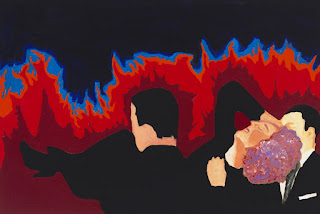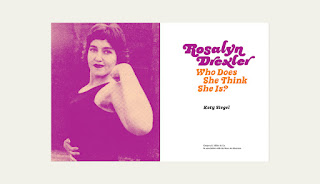Rosalyn Drexler
Rosalyn Drexler
| |
|---|---|

Rosalyn Drexler at her publisher's office
(circa 1960) | |
| Born |
Rosalyn Bronznick
November 25, 1926 |
| Nationality | American |
| Known for | Painting |
Notable work
| Marilyn Pursued by Death, 1963 |
| Movement | Pop Art |
| Spouse(s) | Sherman Drexler (1946-2014; his death) |
Rosalyn Drexler (born 25 November 1926) is an American visual artist, novelist, Obie Award-winning playwright, and Emmy Award-winning screenwriter, and former professional wrestler. Although she has had a polymathic career, Drexler is perhaps best known for her pop art paintings[1] and as the author of the novelization of the film Rocky, under the pseudonym Julia Sorel.[2] Drexler currently lives and works in New York City, New York.[3]
Contents
Early life and education[edit]
Rosalyn Drexler (née Bronznick) was born in 1926 in the Bronx, New York.[4] She grew up in the Bronx and East Harlem, New York. Drexler had considerable exposure to the performing arts as a child, attending vaudeville acts with her friends and family.[5] Her parents also exposed her to the visual arts at an early age, buying her art posters, books,[6] coloring boxes, and crayons, which she has cited as an influence.[7] She attended the High School of Music and Art in New York City where she majored in voice.[1] She attended Hunter College for one semester only before leaving school to marry figure painter Sherman Drexler at 19[6] in 1946.[8] She is the subject of many of her husband's paintings.[9] Together, they had a daughter and a son.
Professional wrestling career[edit]
In 1951, Drexler and her husband lived in Hell's Kitchen in New York near Botner's Gymnasium, where a number of female professional wrestlers practiced.[2] After a friend of Drexler's suggested that she might enjoy trying wrestling, she began to work out at Botners.[2]She soon learned how to wrestle without hurting anyone and how to make maximum noise while wrestling to exaggerate the impact of her performance.[2] Drexler eventually travelled for wrestling matches, which allowed her to travel to the South and to Florida under the character of "Rosa Carlo, the Mexican Spitfire."[10][11] While on tour, she wrestled in odd places such as a graveyard and an airplane-hangar.[4] There is also a photo of her getting ready with an advertisement that she would be fighting Mae Young, a famous professional wrestler.[12] She went on tour around the country, but returned home after becoming upset about racism in the southern states, such as segregated seating and water fountains.[4] Andy Warhol made a series of silkscreen paintings based on a photograph of Drexler as Rosa Carlo.[13]
Drexler's experience as Rosa Carlo later formed the basis of her 1972 critically acclaimed novel To Smithereens.[2] She wrote the novel because she hated the experience, but thought it should not be wasted, and she should "at least get a book out of it."[6] The novel was the basis of the 1980 film Below the Belt. The producers contacted Drexler about the title, to which she said that it was "not a wrestling title at all…[but] they said, 'It sounds sexy.'"[7] When she was 54, she tried getting back into being an athlete and entered a power lifting contest, which she did not win.[7]
She has made several paintings based around women's wrestling, including Take Down (1963),[14] Lost Match (1962), and The Winner (1965).[15]
Writing career[edit]
Novels[edit]
- I Am the Beautiful Stranger (1965)
- One or Another (1970)
- To Smithereens (1972)
- The Cosmopolitan Girl (1974)
- Unwed Widow (1975)—written under the pseudonym Julia Sorel
- Starburn: The Story of Jenni Love (1979)
- Bad Guy (1982)
- Art Does (Not!) Exist (1996)
- Vulgar Lives (2007)
Adapted screenplays[edit]
- Dawn: Portrait of a Teenage Runaway (1976)—Adapted from the screenplay by Dalene Young
- Rocky (1976)—Based on the screenplay by Sylvester Stallone[2]
- Alexander, The Other Side of Dawn (1977)—Adapted from the screenplay by Dalene Young
- See How She Runs (1978)—Adapted from the screenplay by Marvin Gluck
Plays[edit]
- Home Movies (1964).
- The Line of Least Existence and Other Plays (1967)
- "Skywriting" in Collision Course (1968)
- "Hot Buttered Roll" in Theatre Experiment: An Anthology of American Plays (1968)
- Methuen Playscripts (1969)
- "Home Movies" in The Off-Off Broadway Book: The Plays, People, Theatre (1972)
- Fiction (1972)
- "Skywriting" in A Century of Plays by American Women, edited by Rachel France (1979)
- Transients Welcome: Three One-Act Plays (1984)
- "Occupational Hazard" in Women on the Verge: 7 Avant-Garde American Plays (1993)
Productions[edit]
- Home Movies—Judson Memorial Church, Provincetown Playhouse, NYC 1964
- The Investigation—Theatre Company of Boston 1966; New Dramatist's Committee, NYC 1966; Milwaukee Repertory Theater 1966; Open Space Theatre, London 1969; Miami University, Ohio 1979
- The Line of Least Existence—Judson Poets' Theatre, NYC 1969; Theatre of the Living Arts, Philadelphia 1970; Traverse, Edinburgh 1968; Network Theatre, NYC 1980
- Hot Buttered Roll—New Dramatist's Committee, NYC 1968; Milwaukee Repertory Theater 1966; Open Space Theatre, London 1969
- Skywriting—Cafe Au GoGo, NYC 1968; Dowling College, Suffolk County, NY 1973
- The Ice Queen—The Proposition, Boston 1973; Kornblee Gallery, NYC 1965 (with puppets)
- Softly and Consider the Nearness—Manhattan Theatre Club, NYC 1973; West Carolina University, NC 1973
- The Bed Was Full—New Dramatist's Committee, NYC 1972
- She Who Was He—Virginia Commonwealth University, Richmond 1974; Odeon Theatre, New York 1974
- Travesty Parade—Center Theatre Group, Los Angeles 1974
- The Writer's Opera—Theatre for the New City, NYC 1979.
- Graven Image—Theatre for the New City, NYC 1980; Oberlin College, Ohio 1980
- Vulgar Lives—La MaMa Experimental Theatre Club, NYC 1979
- The Tree Artist—Gateway, Long Island, NY 1981
- Starburn—Theatre for the New City, NYC 1983
- The Mandrake—Center Stage, Baltimore 1983
- Dear—SoHo Repertory, NYC 1983
- Room 17C—Omaha Magic, NE 1983
- Delicate Feelings—Theatre for the New City, NYC 1984
Television[edit]
Drexler was one of 15 writers for the 1973 CBS comedy special Lily, starring Lily Tomlin, Alan Alda, and Richard Pryor.
Visual Arts Career[edit]
Drexler began making found-object sculptures for display in her home while living in Berkeley, California where her husband was finishing his art degree. The sculptures were plaster accretions, built around found scrap metal and wood armatures, and reflected the informal Abstract-Expressionist-influenced Beat sculpture of the time.[5] In 1955, Drexler exhibited her first works alongside her husband's paintings.
At the urging of David Smith[7] and dealer Ivan Karp, she continued to exhibit after the couple moved to New York City. One critic called these early works "ridiculous and nutty" sculptures that revealed a "real beauty beneath their I-don't-care attitudes."[16] Her works were shown in New York in 1960 at Reuben Gallery, at which she participated in Happenings.[17] Her work was praised by David Smith and Franz Kline of the New York School. When the Reuben Gallery closed after one year, she received no offers because "women [sculptors] were not bankable at [the] time." She made a swift shift to painting in an attempt to gain more offers.[18] She did odd jobs to make a living while artmaking, including being a waitress, a cigarette girl, a hatcheck, and a masseuse.[6]
By 1961, Drexler started changing her work from assemblage to Pop Art.[19][20] She searched through old magazines, posters, and newspapers to source imagery for her paintings. Her self-taught process consisted of blowing up images from magazines and newspapers, collaging them onto canvas, and then painting over them in bright, saturated colors. She also has a fondness for Elmer's Glue in her work, saying it "doesn't get enough credit for its role in art."[7] Drexler has never had a studio of her own while she wasn't a student, and usually worked anywhere she could, typically the home.[21]
Drexler signed with Kornblee Gallery, where she had solo shows in 1964–1966. In January 1964 her work was included in the "First International Girlie Exhibit" at Pace Gallery, New York. She and Marjorie Strider were the only two women Pop artists included in this exhibition, which also featured Warhol, Lichtenstein, and Tom Wesselmann. Drexler exhibited collages cut and pasted from girlie magazines. The work scandalized some, but her paintings were mostly well received. One critic noted, "Miss Drexler's collage paintings…fly through contemporary life and fantasy with a virtuosic, uninhibited imagination that is refreshingly direct in its frank expression of brutality, desire, pathos and playfulness."[22]
Drexler's paintings continued to enjoy favorable reviews and were exhibited in major Pop art exhibitions throughout the 1960s. She did not gain the level of recognition of many of her male peers; the major themes in her paintings—violence against women, racism, social alienation—were controversial topics in a genre known for being "cool" and detached.[23] She's stated:
Drexler's Pop paintings have been identified more recently as early feminist artworks, although Drexler objected to this categorization, denying any deliberate political message in her work.[24] In spite of this, in 1968, Drexler signed the "Writers and Editors War Tax Protest" pledge, vowing to refuse tax payments in protest against the Vietnam War.[25]
In 2018 her work received renewed critical attention and a career retrospective exhibition at the Rose Art Museum.[26]
Major themes and works[edit]
As well as drawing from her own experience, Drexler's work often revolves around women's roles as portrayed in pulp cinema, including women as moll, femme fatale, home wrecker - those in need of "moral comeuppance".[27] Her images were drawn from easily understood public media.
Her The Love and Violence series is a body of paintings that depicts abusive relationships between men and women. The canvases evoke the covers of pulp fiction novels, B-movie posters, and scenes from gangster films or film noir.[28] Works such as I Won't Hurt You(1964), This is My Wedding (1963), and Rape (1962) depict sexual violence against women. While the men depicted are most often the abusers, in some paintings, such as Kiss Me, Stupid (1964) and Dangerous Liaison (1963), the dynamic between the male and female subjects is left more indeterminate. Other works in this series include The Bite (1963), Love and Violence (1965), and Baby, It's Alright (1963).
Is It True What They Say About Dixie? (1966) was inspired by a newspaper photo of Bull Connor, the police chief who instigated the Birmingham race riot of 1963, leading a group of white supremacists. The figures advance towards the viewer dressed in black suits against a stark white background. The painting, with a title taken from an American popular song, acts as an ironic commentary on the racial violence of her time.[29] Similar in composition and intent is the painting F.B.I. (1964) that both glamorizes the depicted government agents and questions their status as figures of authority.
The Men and Machines series, showing working men with various types of mechanical equipment, portrays Cold-War era images of technological advancements and plays on the cliché of machines as phallic symbols of male sexual power. Paintings in this series include Pilot to Tower (1966). Marilyn Pursued by Death (1967) is an image of Marilyn Monroe being followed by a male figure. Although "Death" appears to be a stalker or member of the paparazzi, the photograph after which the painting was made makes clear that the man is actually her bodyguard.
Paintings made after movie posters include King Kong aka The Dream (1963), modeled after the lobby card for John Lemont's 1961 film Konga, and Chubby Checker (1964), based on the poster for 1961 movie musical Twist Around the Clock.
Connections with other artists[edit]
Drexler has listed Franz Kline and Bill and Elaine de Kooning as close friends of her and her husband.[6] She also had connections to Eva Hesse, George Segal (whom she posed for), Lucas Samaras, Claus Oldenburg, Billy Kluver, Bob Beauchamp, Dodie Müller, Alice Neel, and Joy Harjo. She also worked on plays with John Vaccaro, whom she described as "a terrifying creative projectile…"[7]













































































































No comments:
Post a Comment